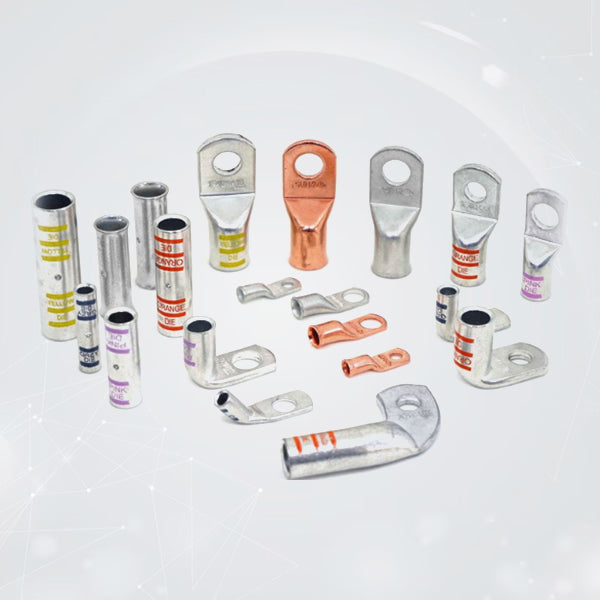
How to Ensure Maximum Current Flow with 4 AWG Tinned Copper Lugs
When it comes to high-amperage electrical systems—whether in marine, automotive, solar, or industrial setups—4 AWG wire is a common workhorse. Thick enough to handle serious current and flexible enough to install in tight spaces, it’s the go-to cable size for many mid- to high-power applications.
But to truly harness the potential of 4 gauge wire, your choice of terminal lug is just as important as the wire itself. Specifically, using 4 AWG tinned lugs ensures that your connections are not only conductive but also protected against corrosion, heat, and long-term wear.
In this post, we’ll walk you through why tinned lugs matter, how to select the best type of 4 gauge lugs, and the steps you can take to maximize current flow in every installation.
Why Your Lugs Matter—A Lot
A chain is only as strong as its weakest link, and in your electrical system, that weak link can easily be a poor-quality lug or a bad crimp.
Here's why your choice of 4 gauge wire lugs directly affects your system’s performance:
-
🔌 They serve as the critical bridge between cable and component.
Lugs connect your cable to batteries, inverters, bus bars, and other high-power components. A weak or poorly installed lug creates resistance and heat. -
⚡ They carry high current loads.
4 AWG wire can handle 85 to 95 amps depending on insulation and environment. Your lugs need to keep up. -
🔥 They can be a source of failure if not properly chosen or installed.
Loose crimps, corrosion, or undersized lugs can cause voltage drops, overheating, or even fires.
What Are 4 AWG Tinned Copper Lugs?
4 AWG tinned copper lugs are terminal ends made from pure copper that have been coated (tinned) with a layer of tin. This tin coating protects the copper from oxidation and corrosion while still providing excellent electrical conductivity.
Benefits of Tinned Copper Lugs:
✅ Corrosion Resistance: The tin layer protects the copper underneath from moisture and chemical exposure, especially in marine, RV, and solar environments.
✅ High Conductivity: Pure copper base ensures minimal electrical resistance and excellent current-carrying capability.
✅ Long-Term Reliability: With proper installation, these lugs will maintain a strong, low-resistance connection for years.
How to Maximize Current Flow with 4 AWG Tinned Lugs
Now that you know the benefits, let’s explore how to make the most of them. Follow these critical steps to ensure your 4 gauge lugs deliver optimal performance:
1. Start with the Right Lug for the Job
When selecting a lug, be sure it's designed specifically for 4 AWG wire. Too tight, and the conductor won’t fully seat; too loose, and the crimp won’t hold.
Choose lugs with the following features:
- Made from tinned copper for corrosion resistance
- Closed barrel design for better mechanical grip
- Sized appropriately for both wire gauge and stud size
- UL Listed or meets SAE standards
💡 Browse SELTERM's 4 AWG Tinned Copper Lug Collection
2. Use Proper Stripping Technique
Strip only as much insulation is needed to fit the wire into the lug barrel—usually around 1/2" to 5/8". Avoid nicking or cutting any wire strands, as this reduces the effective conductor size and increases resistance.
3. Use the Correct Crimping Tool
Never use pliers or generic crimpers for heavy-duty lugs. Use a dedicated hex, indent, or hydraulic crimp tool that matches the lug’s size and shape.
- Crimp in multiple locations for a secure bond
- Visually inspect for deformation, and give a firm tug to test the connection
- Avoid over-crimping, which can crack or weaken the lug
4. Seal with Heat Shrink Tubing
After crimping, apply adhesive-lined heat shrink tubing to seal the joint. This:
- Keeps out moisture and air
- Prevents oxidation and corrosion
- Adds mechanical strain relief
- Improves the longevity of your connection
5. Torque to Spec
When securing your 4 guage tinned lug to a terminal post or bus bar, follow the torque specs recommended by the component or lug manufacturer. Under-tightening can lead to arcing; over-tightening may deform the lug or strip threads.
6. Inspect and Maintain Regularly
In demanding environments—especially marine, off-road, or solar applications—make periodic inspections part of your maintenance schedule.
Look for:
- Signs of corrosion or discoloration
- Loosened bolts
- Cracked insulation or exposed wire
- Temperature hotspots
If you see any signs of wear or poor performance, replace the lug before it fails.
Why SELTERM 4 Gauge Tinned Copper Lugs Stand Out
Professionals across industries trust SELTERM lugs for their superior quality and reliability. SELTERM’s 4 AWG tinned copper lugs are engineered to meet the demands of high-amperage, high-vibration environments like boats, RVs, solar arrays, and industrial equipment.
✅ Manufactured from 99.9% pure oxygen-free copper
✅ Electro-tin plated for excellent corrosion resistance
✅ Offered in a wide range of stud sizes and configurations
✅ UL Listed and RoHS compliant
✅ Easy to install with standard heavy-duty crimp tools
🔗 View the Full SELTERM 4 AWG Tinned Copper Lug Collection
Applications Where 4 AWG Tinned Lugs Excel
- 🛥 Marine Electrical Systems – Corrosion resistance is a must in saltwater environments
- 🔋 Solar Battery Banks – Secure, low-resistance connections in high-current DC setups
- 🚛 Automotive & RV Power Systems – Ideal for battery and inverter cables
- ⚡ Industrial Equipment – Where durability and conductivity are critical
- 🏡 Off-Grid Installations – With exposure to the elements, tinned lugs offer longevity
Final Thoughts
To ensure maximum current flow, every detail matters—from the cable you choose to the way you crimp your lugs. But one of the smartest upgrades you can make is switching to 4 AWG tinned copper lugs. Not only do they provide excellent conductivity, but they also withstand moisture, oxidation, and years of vibration and heat.
If you’re building a system you want to count on—choose tinned. Choose properly sized. Choose precision.
Ready to Power Your System the Right Way?
👉 Shop SELTERM 4 AWG Tinned Copper Lugs Now

